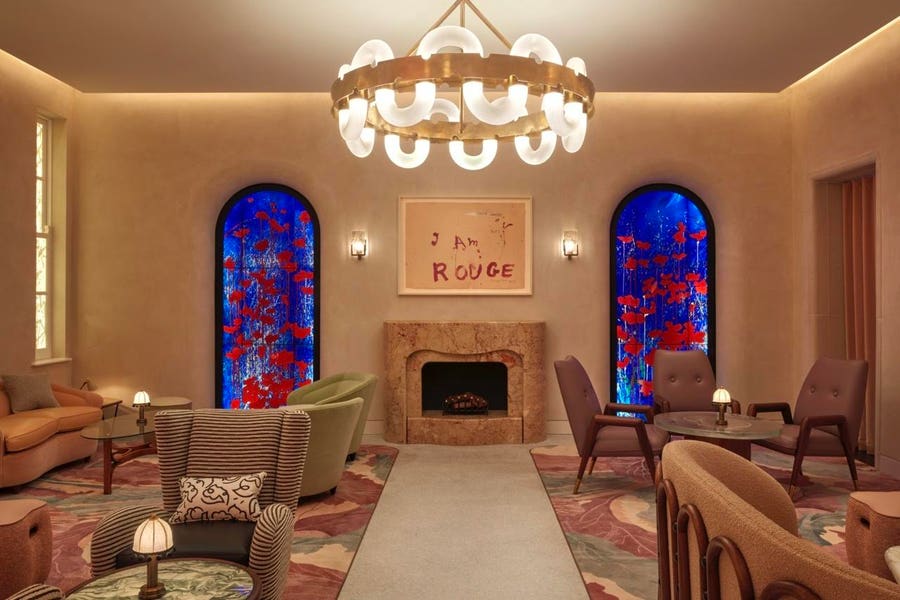
The name may not immediately ring any bells. But if you’ve enjoyed a cocktail at the famed Red Room bar in London’s , booked the penthouse at Claridge’s (or enjoyed dinner at the iconic property’s restaurant) or checked into Maybourne’s luxe properties in or just outside (in Roquebrune-Cap Martin) then you’ve experienced interiors that he’s designed.
An intimate corner in one of the bars at the Maybourne Riviera.
James McDonald
The 42 year-old Irish native splits his time between London and New York, where a staff of 70 is currently overseeing 30 projects around the globe including the reimagining of the Shore Club in Miami and a Gulfstream private jet from the ground up. He launched line of and decorative accessories last year, as well as a shop in London, and his first monograph debuted last month. is an over-sized tome with a foreword by his former employer, the renowned architect , and featuring a “greatest hits” of sorts. The work is impressive, with a depth and breadth normally associated with firms older than his ten years.
In the past year his firm, Bryan O’Sullivan Studio, was named to both Architectural Digest’s prestigious AD100 list of the world’s top designers, as well as House & Garden (U.K.) Top 100 list. “Particularly with the hospitality projects, he creates total environments that are transporting,” noted Selldorf. “His pleasure in materials, shapes and patterns and relating one to another is something I really admire.”
The bathroom in a Paris apartment designed by Bryan O’Sullivan.
James McDonald
Despite his insane travel schedule – which in the next few months includes Miami, New York, London, Paris, Berlin, Ireland and the Glastonbury Festival — he made time to submit to a series of questions, both personal and professional:
Early design influences: My granddad had a really good eye for design. He was a self-taught builder and had a studio in a shed off his house where he would draft on an old drawing board. The main thing he did was restore churches, so that studio also had old stained glass and other things from the restorations. I used to go there a lot, I was obsessed with his drawings. And when I was 19 I worked for a firm in Dublin called Duff Tisdall. They were architects and interior designers and had an interiors shop. I was taking some time off school – I had been studying hospitality management – and was trying to figure out if I wanted to switch to architecture.
The Berkeley Bar at the Berkeley Hotel, London, with a mural by New York-based artist TM Davy.
James McDonald
Early experience in hospitality: My mum, Marian, opened a coffee shop and delicatessen in Kenmare, County Kerry, when I was two years old. It was called Mickey Ned’s, after my Dad. She ran that for 20-odd years. Later she opened a bar and restaurant, also called Mickey Ned’s. (They two Mickey Ned’s did not exist at the same time). The second one was my first design project. My mum let me be involved with all the design decisions, from choosing light fixtures to figuring out the floor plan. And before that I had worked in the kitchen at the Sheen Falls Lodge, a five-star hotel in the area. It had a Michelin star at the time.
The Red Room at London’s Connaught Hotel, designed by Bryan O’Sullivan.
James McDonald
Hospitality versus residential design: I absolutely love doing both, but they are very different. Commercial projects are less personal, more business, and generally move faster. Residential takes more time, and there’s a definite limit to the amount of residential you can take on at one time. Why? Because residential clients need a lot more of your time and you need to give them the time that they need.
Advice for those considering working with an interior designer: It’s really important to develop a close relationship, because it’s a long process that can take three to five years from start to finish. You need to establish trust, and both parties need to learn to listen so everybody feels heard.
New clients sometimes don’t realize that designs don’t happen overnight, it is a process, you won’t instantly see a CGI of your finished room. It takes time for us as designers to understand what these rooms are going to look like. It sometimes takes a before these rooms start to reveal themselves: layouts, functionality, interior architecture, furniture.
The living room in a Paris townhouse designed by Bryan O’Sullivan.
James McDonald
Advice for young interior designers: Work for as many people as you can, and work for decent stints. There’s no point going somewhere for a month. You need to do three or four years with someone to really immerse yourself. I have certain ex-colleagues that only worked in one place and then went out on their own. They would’ve learned a lot from whatever boss they were working for, but I think it is important to work for several bosses so you can pick and choose what you like, and develop your own style.
The interns that stand out in our studio are interested and keen. They are wanting to work on things and go the extra mile. I think the goal is get as much exposure as you can, see as much as you can, because there is so much to learn.
The cinema room of a London townhome, designed by Bryan O’Sullivan.
Helen Carthcart
What makes a good hotel room: I could write a book about this. The key of good hotel room design is functionality, and there’s so few hotels that get this right. There needs to be somewhere beside the bed to plug in electronics, but there are 5-star hotels we’ve stayed in with no outlet anywhere near the bed. Light switches are another thing that drives me crazy. I want the simplest system, where I can switch everything off from next to the bed, and don’t have to go round the room turning every individual thing off. And surface space in a bathroom. It is mind boggling that hotels, even recently renovated ones, don’t have enough space to put your toothbrush beside the sink.
Suite 410 at Claridge’s in London, designed by Bryan O’Sullivan.
James McDonald
An interior you’d like to have a go at: We were in L.A. last year and went for lunch at the Beverly Hills Hotel and I was quite disappointed. In my head it was very Dorothy Draper, but a lot of that doesn’t exist there anymore. I would love a go at putting that back to what I feel it should be.
How having a child changed your design approach: We design for a lot of young families, and they always stress how kid’s areas need to have bullet proof materials because they have sticky hands that go on everything. I’ve always heard clients say this, but having lived through it I now have a greater understanding and appreciation.
Luckily, we renovated our apartment two years ago, and it has a lot of our furniture collection in it, including some of the prototypes we developed. Our furniture is very curvy, which it turns out is very child friendly. That should be our strap [tag] line: Family Friendly Designs – !
Bryan O’Sullivan photographed at The Berkeley Bar & Kitchen, London
© Mark Cocksedge

